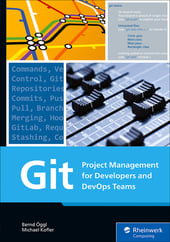In modern software development, collaboration among developers and efficient tracking of codebase changes pose significant challenges.
Managing different software versions and swiftly reverting to prior states can take time and effort, leading to potential errors and conflicts.
Teams often face disruptions when working on new features or bug fixes, as these alterations may impact the main codebase. Around 85% of developers believe that Git has made collaboration easier, showing how powerful it can be in a development workflow.
This blog post concisely overviews Git's significance in modern software development. Intended for developers, project managers, and anyone involved in software development, it aims to elucidate the fundamental concepts and benefits of Git, whether you're new to it or seeking a refresher.
Understanding Git
Git is a distributed version control system that tracks source code changes during software development. It utilizes basic concepts and terminology such as repository, commit, branch, merge, etc. Understanding Git involves grasping these fundamentals.
A repository is a storage location where files and their history are stored. Commits are like checkpoints that capture the current state of the files in the repository. Branches allow developers to work on new features or bug fixes without impacting the main codebase, and merging allows these changes to be integrated back into the main branch.
Developers can effectively collaborate, manage code changes, and track project history by understanding these basics.
Setting Up Git
To install Git on different operating systems, follow the specific installation instructions. Download the Git for Windows installer from the official website and run the installer. For Mac, you can install Git through the Xcode Command Line Tools or download the Git installer from the official website.
For Linux, use your package manager to install Git.
Once Git is installed, setting up the user information and SSH keys is important. This can be done by using the following commands in the terminal:
```bash
git config --global user.name "Your Name"
git config --global user.email "your.email@example.com"
```
To generate an SSH key, use the following command in the terminal:
```bash
ssh-keygen -t rsa -b 4096 -C "your.email@example.com"
```
Follow the prompts to create the SSH key, and then add it to the ssh-agent with the command:
```bash
ssh-add ~/.ssh/id_rsa
```
Finally, add the SSH key to your Git account by copying the contents of the `id_rsa.pub` file to the SSH keys section of your account settings on the Git hosting provider's website.
Following these steps, you can successfully set up Git with the necessary user information and SSH keys.
Git Workflow Basics
The Git workflow begins with initializing a repository using the "git init" command. This sets up the project to begin tracking changes.

After making changes to files, the next step is to stage them using "git add" and then commit the changes using "git commit". This saves a snapshot of the changes to the project's history.

To push and pull changes to and from remote repositories, you can use the "git push" and "git pull" commands. Pushing sends your committed changes to a remote repository, while pulling retrieves changes from a remote repository to your local one.


Branching and merging are essential for managing different features or versions of a project. You can create a new branch using "git checkout -b" and then merge it back into the main branch using "git merge". This allows for parallel development and easy integration of new features.


The Git workflow involves initializing a repository, staging and committing changes, pushing and pulling from remote repositories, and using branching and merging strategies for efficient development and collaboration. Mastering these basics will set a solid foundation for efficient version control and collaboration in your projects.
Collaborative Development with Git
Collaborative development with Git involves utilizing best practices for team collaboration to streamline the code review process and manage access and permissions in shared repositories. One of the best practices for collaboration in Git is utilizing pull requests for code review. This allows team members to propose changes to the codebase, discuss potential modifications, and ultimately merge the code into the repository once all stakeholders have provided feedback and approval.
Additionally, managing access and permissions in shared repositories is crucial for ensuring that the right individuals have access to the codebase. Using Git, administrators can easily assign roles and permissions to team members, controlling who can view, edit, or merge the code. This helps maintain the codebase's integrity and minimize the risk of unauthorized changes.
Utilizing Git for collaborative development allows teams to work together efficiently and effectively. By implementing pull requests for code review and effectively managing access and permissions in shared repositories, teams can ensure that their codebase remains secure, well-maintained, and conducive to collaboration.
Integrating Git with Development Tools
There are several popular Git integrations with development tools that help automate workflows and improve efficiency. IDEs such as Visual Studio Code, IntelliJ IDEA, and Eclipse have built-in support for Git, providing seamless integration for version control within the development environment.
These integrations allow developers to perform Git operations such as commit, push, pull, and merge directly within the IDE, simplifying the development process.
Build tools like Maven, Gradle, and Ant also have Git integrations that enable developers to automate the build and release processes based on the Git repository changes. This ensures that the latest code changes are automatically built and deployed, improving the overall development and release cycles.
CI/CD pipelines, such as Jenkins, GitLab CI, and Travis CI, integrate with Git to enable automated testing and deployment processes. These pipelines can be triggered by Git events, such as code pushes or pull requests, allowing continuous integration and code change delivery.
In addition to these integrations, developers can automate workflows with Git hooks (scripts triggered by Git events) such as pre-commit or post-merge. This allows custom actions to be performed before or after Git operations, further enhancing the automation capabilities within the development process.
Git Best Practices
Regarding Git’s best practices, the following should be considered:
- Using descriptive and meaningful commit messages that accurately reflect the changes being made is essential. This helps track the project's history and understand each commit's purpose and context.
- Keeping commits small and focused is also a good practice, addressing a single issue or change in each commit.
- In Git-based development, security practices are essential to ensure the safety of the codebase. This includes using secure communication protocols, such as HTTPS or SSH, for pushing and pulling code from remote repositories.
- It is also essential to regularly review and update access control settings to prevent unauthorized access to the codebase.
- Avoid committing sensitive information, such as passwords, API keys, or other credentials, to the version control system is essential.
Troubleshooting Common Git Issues
When working with Git, it's common to encounter errors and problems that hinder productivity. Some of the most common issues include merge conflicts, detached HEAD, and missing commits.
To resolve merge conflicts, you can use the `git status` command to identify which files have conflicts, then use `git add` and `git commit` to resolve the conflicts and complete the merge.
If you find yourself in a detached HEAD state, use the `git reflog` command to find the lost commits, and then use `git checkout` to move back to the desired commit.
For missing commits, you can use the `git reflog` and `git reset` commands to recover lost data and undo changes.
In addition, always ensure that you are working in the correct branch and have the latest changes by using `git fetch` and `git pull` to update your local repository.
Conclusion
The key takeaways from learning about Git include understanding the importance of version control, the benefits of using Git for collaborative software development, and the basic commands and workflows. Git provides a powerful way to track changes, collaborate with others, and manage different versions of your code.
It's important to encourage further practice and exploration of Git to grasp its potential and become proficient fully. Many resources are available, such as online tutorials, documentation, books, and communities where you can ask for help and learn from others. By practicing regularly and exploring different features and workflows, you can become more comfortable and confident using Git in your software development projects.
Learning Git is an ongoing process, and making mistakes is okay. The more you use Git, the more familiar and comfortable you will become with it. So, feel free to dive in, experiment, and continue to learn. With dedication and practice, you can master Git and use it effectively to streamline your development process and collaborate with others more efficiently.




Comments